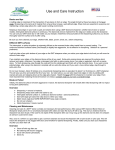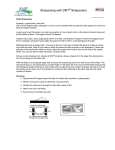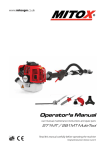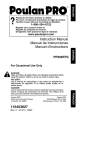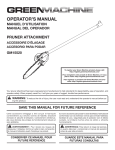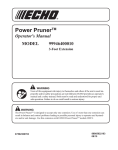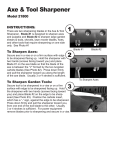Download DMT WM8EF-WB Use and Care Manual
Transcript
Use and Care Instruction COPYRIGHT © 2008-2013 DMT Basics and tips A cutting edge is comprised of the intersection of two planes to form an edge. The angle formed by these two planes is the bevel angle. Sharpening is the removal of material from a bevel face to keep a well-defined edge. Sharp tools are essential to everyone and maintaining a sharp edge allows for a safer easier working environment. Keeping a sharp edge on your tools is quick and simple when using a DMT Diamond sharpener, whether bench stone or pocket models, interrupted diamond surface or continuous. The diamonds remove material from the edge as it slides across the sharpener. You can use your DMT stone dry or with water; as you sharpen, metal fines will accumulate on the sharpening surface so you should thoroughly wash the surface and dry after using. Be sure you have cleaned your edge, whether knife, blade, pruner, chisel, etc., before sharpening. Different DMT surfaces The interrupted, or polka dot pattern is extremely efficient as the recessed holes collect metal fines to prevent loading. The continuous diamond surfaced stone (Dia-Sharp®) is slightly less aggressive, but as effective in sharpening. Selection is a personal preference. Grit Selection Please note that grit designation is marked on Dia-Sharp® models, color coded on interrupted surface models (Coarse - Blue; Fine - Red; Extra-Fine - Green) Coarse (45 micron / 325 mesh) Quickly restores a neglected edge. Fine (25 micron / 600 mesh) Puts a keen edge on a regularly maintained edge. Extra-Fine (9 micron / 1200 mesh) Polishes and refines a razor edge after sharpening with a coarser grit It will only take a few quick strokes of your edge on the DMT sharpener when you notice your edge starts to dull and you will never be without a keen edge. If you maintain your edges, a fine diamond stone will be all you need. If you have edges that have been neglected, start with a coarse stone and finish with a fine diamond. If you want a more polished edge, after using a fine diamond, complete with an extra-fine stone. Do not over sharpen. About 30 strokes on a conventional sharpening stone is equivalent to about 5 or 6 strokes on a DMT sharpener. This will save you time and extend the life of your tool. You can also repair lost edges or nicks by starting with coarser grit sizes and stepping down as the edge gets sharper. Match the bevel with the sharpener to maintain your edge. Even more important than matching the bevel however is to keep a constant angle so you have a consistent edge. Break-in Period Initially, the diamond surface will seem aggressive in nature; the diamond sharpener will smooth after initial sharpening with no impact to long term performance. Overview Sharpening = removal of material. Sharpening keeps tools safer and easier to use. Interrupted diamond surface vs. continuous diamond surface - personal preference. Start with larger grit sizes then step down to refine your edge. Match bevel angle (but MORE IMPORTANT keep angle constant). Do not over sharpen. Initial sharpening = break-in period Use and Care Instruction COPYRIGHT © 2008-2013 DMT Cleaning and Maintenance Cleaning and care of a DMT® stone is simple and necessary for best performance. After using a DMT Diamond Bench Stone or Sharpener simply wet it (if it is not already lubricated with water) and wipe the slurry off with a rag. This slurry is evidence that the sharpener has done its job. If the swarf is not wiped off the sharpener after use it may clog up the diamond and not allow it to sharpen as well as it could were it clean. Also, once in a while it is a good idea to get a common cleanser and scrub the sharpener with a nylon brush or nylon pad. This will ensure the sharpener is not clogged with slurry and will allow for optimal sharpening. Finally, make sure you store your sharpeners dry after you clean them off. Overview Clean off with rag after use Not cleaning will result in clogging Scrub with cleaner periodically Store dry


